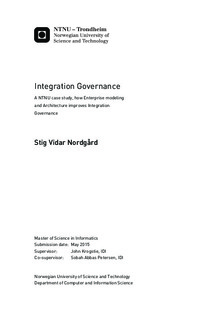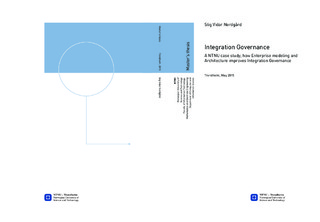| dc.description.abstract | This chapter presents the summary of this report. It aim to summarize the activities related to the Problem description in chapter 1.3. In the section for problem description below the main activities are presented with regards to accomplishment and the contributions from the author of this master thesis is marked: contribution from author .
Problem description:
The problem description is based on the assignment and described in chapter 1.3:
Through the master thesis the student shall study and evaluate how Enterprise modeling and Architecture improves integration governance at NTNU supported by TOGAF. Case to be studied is TIA (Service Oriented Integration Architecture at NTNU). The student also shall research best practice for Integration Governance at comparable enterprises. By comparing and analyzing best practice with TOGAF and improvements identified by Enterprise modeling the student shall propose an Integration Governance model for NTNU and steps for implementation.
This necessitates following main activities:
1. Literature study and study of relevant NTNU internal documents:
(a) Concepts found in the literature study are defined in chapter 2: Definition of
Concepts. And the literature is referenced in the Bibliography. The concept Integration
Governance is defined and introduced in chapter 2 and is an contribution from author.
(b) Relevant NTNU internal documents are referenced in the Bibliography.
2. Study TIA Case. Focus on FS, Common Student System:
(a) The TIA case and FS are described in chapter 6.
(b) TIA and FS case are analyzed in Appendix G, Enterprise Model and Architecture As-Is and
in chapter 8: Enterprise Model and Architecture To-Be.
3. TIA analysis supported by TOGAF:
(a) TIA As-Is is analyzed in Appendix G, Enterprise model and Architecture As-Is
(contribution from author). And following TOGAF phases are described:
* Preliminary Phase
* A - Architecture Vision
* B - Business Architecture
* C - Information Systems Architecture
* D - Technology Architecture
(b) TIA To-Be is analyzed in chapter 8: Enterprise model and Architecture To-Be
(contribution from author). And following TOGAF phases are described:
* Preliminary Phase
* A - Architecture Vision
* B - Business Architecture
* C - Information Systems Architecture
* D - Technology Architecture
* E - Opportunities Solutions
* F - Migration Planning
* G - Implementation Governance
* H - Architecture Change Management
4. Create Enterprise model and Architecture. Architectural artifacts such as:
* Information model:
Information model is described chapter 8.4.3 Information Model. The most important
information objects is FS (Common Student System) and their relations are described. I
addition figure 8.9, TIA-FS Information Model, visualize how the FS information objects
are applied in different contexts. These are contributions from author.
The information model is based on regulations referring to the Act relating to
Universities and University Colleges of 1 April 2005, no. 15 (71).
* Security and classification of information:
NTNU Information Security Policy and Principles is described in chapter 8.1.3.
visualized by figure 8.3: Information Classification and Security Levels.
A security and classification model is described in figure 8.9 Improved model for
security and classification of information. This model is a contribution from author.
And this model is introduced post evaluation.
5. Enterprise model and architecture:
(a) Enterprise model and architecture is created, supported with TOGAF, are created in
Appendix G, Enterprise Model and Architecture As-Is (contribution from author) and
chapter 8: Enterprise Model and Architecture To-Be (contribution from author).
(b) Best practice Integration Governance model (figure 9.1) based on Foundation of Execution
including Operation Model, Enterprise Architecture (EA) and IT engagement model,
represented by figure 9.1, is an enterprise model and architecture created with
different architectural views compared with TOGAF expressing similar and overlapping
architectural structures.
(c) Model development and testing is described in Appendix I (contribution from author).
(d) List of architectural artifacts is presented in Appendix L (contribution from author).
6. Conduct best practice surveys at minimum three comparable enterprises:
(a) Questionnaire attempting to find best practice for Integration Governance in described
in Appendix A (contribution from author).
(b) Reasoning behind questionnaire is described in chapter 3 Integration Governance best
practice survey (contribution from author).
(c) External surveys conducted to find Integration Governance best practice is described in
Appendix B (contribution from author). Three comparable enterprises was characterized
having a best practice by high degree of business process standardization and high
degree of business process integration ( Unification operation model). This expressed
in figure 4.1 Enterprise operation model categorization (contribution from author).
(d) Internal NTNU surveys conducted to find actual NTNU Integration Governance best practice
is described in Appendix C (contribution from author).
7. Best practice analysis:
(a) Best practice analysis is described in chapter 4 Integration Governance best practice
analysis (contribution from author).
(b) Appendix D compares the 3 best practices represented by Statkraft, Sykehusparner and
Statoil (contribution from author).
(c) Appendix E contains a qualitative analysis of the best practice enterprises comparison
of Sykehuspartner, Statoil and Statkraft (contribution from author).
(d) Chapter 13 Discussion, assess thesis hypothesis 2, H2: There is a best practice for
Integration Governance (contribution from author).
8. Align best practice analysis with Enterprise model and Architecture:
(a) Best practice is applied in chapter 8: Enterprise Model and Architecture To-Be
(contribution from author).
(b) Chapter 9: Foundation of Execution and gap analysis, aim to align Enterprise Model and
Architecture To-Be with foundation execution for NTNU based on best practice. And it aim
to present gap analysis based on actual practice and best practice (contribution from
author).
9. Evaluation:
(a) Evaluation is conducted in chapter 10 Model Evaluation (contribution from author).
(b) Evaluation methods conducted are: Quantitative and qualitative evaluations based on
interviews, evaluation based on Competency questions and evaluation by the SEQUAL
method.
(c) Evaluation interviews are described in Appendix J (contribution from author).
(d) Qualitative evaluation is described in Appendix K (contribution from author).
(e) The SEQUAL evaluation in this thesis contain following perspectives:
* Semantic and perceived semantic quality
* Syntactic quality
* Pragmatic quality
10. Create Integration Governance model for NTNU:
(a) Integration Governance Model for NTNU, represented by figure 11.3, is described in
chapter 11 Integration Governance model (contribution from author).
(b) The NTNU Integration Governance model (figure 11.3) in based on best practice
Integration Governance model (figure 9.1) adjusted after evaluation conducted in chapter
10 Model Evaluation.
11. Propose steps for implementation of Integration Governance at model at NTNU:
(a) Chapter 13: Implementation steps, proposes implementation steps for implementing
Integration Governance model for NTNU (contribution from author).
(b) The implementation steps are based on chapter 9.3 Gap analysis, chapter 10 Model
evaluation and interviews (Appendix C and Appendix J).
Expected outcome is an Integration Governance model for NTNU. The main purpose of the
Integration Governance model is to govern how decisions are made among stakeholders
concerning integration at NTNU.
* Integration Governance Model for NTNU, is represented by figure 11.3, described in
chapter 11 (contribution from author).
* The purpose of the model is evaluated in chapter 10 Model evaluation (contribution
from author). | |

